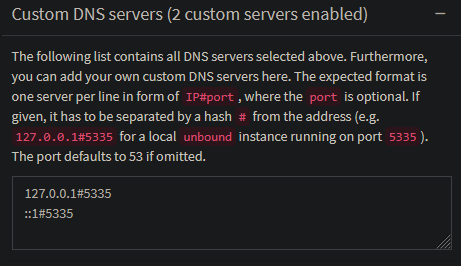Using rgxg (ReGular eXpression Generator) to generate a RegEx that matches all IPv4 & IPv6 addresses
In "Little Helper Scripts - Part 3: My Homelab CA Management Scripts", I mention that the regular expressions I use for identifying IPv4 and IPv6 addresses are rather basic. In particular, the IPv6 RegEx simply assumes that anything containing a colon is an IPv6 address.
When I jokingly asked on Mastodon if anyone had a better RegEx, I mentioned my script enhancements. My former colleague Klaus Umbach recommended rgxg (ReGular eXpression Generator) to me. It sounded like it would solve my problem exactly.
Installing rgxg
The installation on Debian is pretty easy as there is a package available.
root@host:~# apt-get install rgxg
Reading package lists... Done
Building dependency tree... Done
Reading state information... Done
The following additional packages will be installed:
librgxg0
The following NEW packages will be installed:
librgxg0 rgxg
0 upgraded, 2 newly installed, 0 to remove and 0 not upgraded.
Need to get 24.4 kB of archives.
After this operation, 81.9 kB of additional disk space will be used.
Do you want to continue? [Y/n]
Get:1 http://debian.tu-bs.de/debian bookworm/main amd64 librgxg0 amd64 0.1.2-5 [15.3 kB]
Get:2 http://debian.tu-bs.de/debian bookworm/main amd64 rgxg amd64 0.1.2-5 [9,096 B]
Fetched 24.4 kB in 0s (200 kB/s)
Selecting previously unselected package librgxg0:amd64.
(Reading database ... 40580 files and directories currently installed.)
Preparing to unpack .../librgxg0_0.1.2-5_amd64.deb ...
Unpacking librgxg0:amd64 (0.1.2-5) ...
Selecting previously unselected package rgxg.
Preparing to unpack .../rgxg_0.1.2-5_amd64.deb ...
Unpacking rgxg (0.1.2-5) ...
Setting up librgxg0:amd64 (0.1.2-5) ...
Setting up rgxg (0.1.2-5) ...
Processing triggers for man-db (2.11.2-2) ...
Processing triggers for libc-bin (2.36-9+deb12u10) ...
root@host:~#Generating a RegEx for IPv6 and IPv4
Klaus already delivered the example for the complete IPv6 address space. For IPv4 it is equally easy:
# RegEx for the complete IPv6 address space
user@host:~$ rgxg cidr ::0/0
((:(:[0-9A-Fa-f]{1,4}){1,7}|::|[0-9A-Fa-f]{1,4}(:(:[0-9A-Fa-f]{1,4}){1,6}|::|:[0-9A-Fa-f]{1,4}(:(:[0-9A-Fa-f]{1,4}){1,5}|::|:[0-9A-Fa-f]{1,4}(:(:[0-9A-Fa-f]{1,4}){1,4}|::|:[0-9A-Fa-f]{1,4}(:(:[0-9A-Fa-f]{1,4}){1,3}|::|:[0-9A-Fa-f]{1,4}(:(:[0-9A-Fa-f]{1,4}){1,2}|::|:[0-9A-Fa-f]{1,4}(::[0-9A-Fa-f]{1,4}|::|:[0-9A-Fa-f]{1,4}(::|:[0-9A-Fa-f]{1,4}))))))))|(:(:[0-9A-Fa-f]{1,4}){0,5}|[0-9A-Fa-f]{1,4}(:(:[0-9A-Fa-f]{1,4}){0,4}|:[0-9A-Fa-f]{1,4}(:(:[0-9A-Fa-f]{1,4}){0,3}|:[0-9A-Fa-f]{1,4}(:(:[0-9A-Fa-f]{1,4}){0,2}|:[0-9A-Fa-f]{1,4}(:(:[0-9A-Fa-f]{1,4})?|:[0-9A-Fa-f]{1,4}(:|:[0-9A-Fa-f]{1,4})))))):(25[0-5]|2[0-4][0-9]|1[0-9]{2}|[1-9]?[0-9])(\.(25[0-5]|2[0-4][0-9]|1[0-9]{2}|[1-9]?[0-9])){3})
# RegEx for the complete IPv4 address space
user@host:~$ rgxg cidr 0.0.0.0/0
(25[0-5]|2[0-4][0-9]|1[0-9]{2}|[1-9]?[0-9])(\.(25[0-5]|2[0-4][0-9]|1[0-9]{2}|[1-9]?[0-9])){3}Modifying hostcert.sh
All that is left to is define definite start and endpoints for the RegEx (^ and $) and test it.
user@host:~/git/github/chrlau/scripts/ca$ git diff
diff --git a/ca/hostcert.sh b/ca/hostcert.sh
index f743881..26ec0b0 100755
--- a/ca/hostcert.sh
+++ b/ca/hostcert.sh
@@ -42,16 +42,18 @@ else
CN="$1.lan"
fi
-# Check if Altname is an IPv4 or IPv6 (yeah.. very basic check..)
-# so we can set the proper x509v3 extension
+# Check if Altname is an IPv4 or IPv6 - so we can set the proper x509v3 extension
+# Note: Everything which doesn't match the IPv4 or IPv6 RegEx is treated as DNS altname!
for ALTNAME in $*; do
- if [[ $ALTNAME =~ ^[0-9]+\.[0-9]+\.[0-9]+\.[0-9]+$ || $ALTNAME =~ \.*:\.* ]]; then
+ if [[ $ALTNAME =~ ^(25[0-5]|2[0-4][0-9]|1[0-9]{2}|[1-9]?[0-9])(\.(25[0-5]|2[0-4][0-9]|1[0-9]{2}|[1-9]?[0-9])){3}$ || $ALTNAME =~ ^((:(:[0-9A-Fa-f]{1,4}){1,7}|::|[0-9A-Fa-f]{1,4}(:(:[0-9A-Fa-f]{1,4}){1,6}|::|:[0-9A-Fa-f]{1,4}(:(:[0-9A-Fa-f]{1,4}){1,5}|::|:[0-9A-Fa-f]{1,4}(:(:[0-9A-Fa-f]{1,4}){1,4}|::|:[0-9A-Fa-f]{1,4}(:(:[0-9A-Fa-f]{1,4}){1,3}|::|:[0-9A-Fa-f]{1,4}(:(:[0-9A-Fa-f]{1,4}){1,2}|::|:[0-9A-Fa-f]{1,4}(::[0-9A-Fa-f]{1,4}|::|:[0-9A-Fa-f]{1,4}(::|:[0-9A-Fa-f]{1,4}))))))))|(:(:[0-9A-Fa-f]{1,4}){0,5}|[0-9A-Fa-f]{1,4}(:(:[0-9A-Fa-f]{1,4}){0,4}|:[0-9A-Fa-f]{1,4}(:(:[0-9A-Fa-f]{1,4}){0,3}|:[0-9A-Fa-f]{1,4}(:(:[0-9A-Fa-f]{1,4}){0,2}|:[0-9A-Fa-f]{1,4}(:(:[0-9A-Fa-f]{1,4})?|:[0-9A-Fa-f]{1,4}(:|:[0-9A-Fa-f]{1,4})))))):(25[0-5]|2[0-4][0-9]|1[0-9]{2}|[1-9]?[0-9])(\.(25[0-5]|2[0-4][0-9]|1[0-9]{2}|[1-9]?[0-9])){3})$ ]]; then
+ #if [[ $ALTNAME =~ ^[0-9]+\.[0-9]+\.[0-9]+\.[0-9]+$ || $ALTNAME =~ \.*:\.* ]]; then
IP_ALTNAMES+=("$ALTNAME")
else
DNS_ALTNAMES+=("$ALTNAME")
fi
done
+# TODO: Add DNS check against all DNS Altnames (CN is always part of DNS Altnames)
echo "CN: $CN"
echo "DNS ANs: ${DNS_ALTNAMES[@]}"
echo "IP ANs: ${IP_ALTNAMES[@]}"And it seems to work fine. Notably all altnames who don't match any of the RegExes are treated as DNS-Altname which can cause trouble hence I think about adding a check to resolve all provided DNS names prior the certificate creation.
root@host:~/ca# ./hostcert.sh service.lan 1.2.3.4 fe80::1234 service-test.lan 2abt::0000 999.5.4.2 2a00:1:2:3:4:5::ffff
CN: service.lan
DNS ANs: service.lan service-test.lan 2abt::0000 999.5.4.2
IP ANs: 1.2.3.4 fe80::1234 2a00:1:2:3:4:5::ffff
Enter to confirm.
^C
root@host:~/ca#
